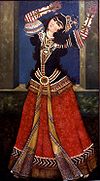Persian embroidery
| Part of a series on the |
| Culture of Iran |
|---|
 |
|
|
Persian embroidery is a type of Persian art and handicraft.[1]
History
It has been speculated that Persian embroidery existed from ancient times and at least from the time of the
The earliest piece of physical Persian embroidery is from the
Peculiarities
The chain stitch (Persian: gulab-duzi) was used in many types of Persian embroidery, most notably in the regional Rasht embroidery.[4] The embroidery featuring metal tinsel in tulle (Persian: naghdeh-duzi) is a common technique of the Jews of Iran.[3]
Pateh is an Iranian traditional needlework folk art originated in and is largely associated with Kerman province, and traditionally created by women.[6] Pateh needlework is created using silk thread, common designs include the cypress tree and the sun with flourishes of paisley patterns.[6]
See also
- Arts of Iran
- Shahin Ebrahimzadeh-Pezeshki, textile artist, and historian of Persian traditional clothing and Iranian tribal clothing
- Sichuan embroidery
References
- ISSN 1913-1852.
- ^ a b c d Wulff, Hans E. (1966). The Traditional Crafts of Persia; their Development, Technology, and Influence on Eastern and Western Civilizations. Internet Archive. Cambridge, MA: M.I.T. Press. pp. 216–218.
- ^ ISBN 978-0-85772-765-7.
- ^ "Hanging, 19th century". Metropolitan Museum of Art.
- ^ "Sermeh doozi, luxury ancient Iranian embroidery". Tehran Times. 2020-11-28. Retrieved 2023-02-21.
- ^ a b "The History of Pateh". Pateh Serah. Archived from the original on September 16, 2014.
Further reading
- Kendrick, A.F. (1937). Brief Guide to the Persian Embroideries. London: Victoria and Albert Museum. ISBN 9781447400677.



